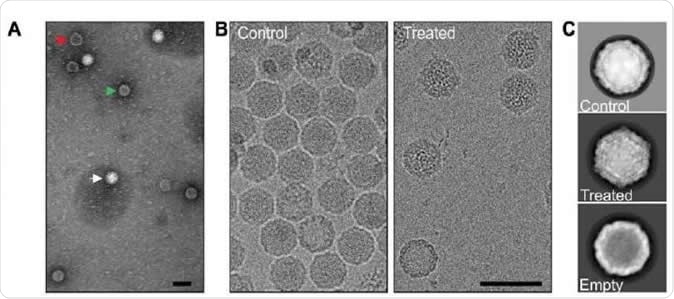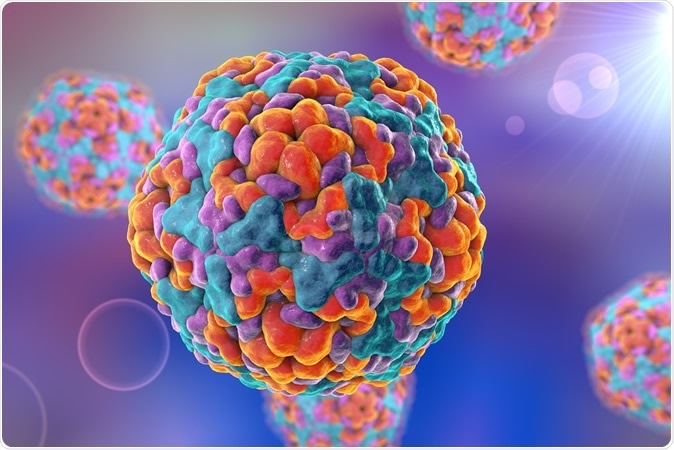Researchers from the Nanoscience Center at the University of Jyväskylä in collaboration with those at the University of Helsinki have found that body proteins called albumin and certain ions within the attacked host cells can affect the genetic workings of enteroviruses and enhance their infection. Their study results are published in the latest issue of the Journal of Virology this month. The study is titled, “Extracellular Albumin and Endosomal Ions Prime Enterovirus Particles for Uncoating That Can Be Prevented by Fatty Acid Saturation”.

These are enteroviruses in electron microscope. Albumin helps enteroviruses to open. Image Credit: University of Helsinki and University of Jyväskyla/Visa Ruokolainen and Ausra Domaska
The researchers explain that enteroviruses are one of the commonest infections leading to both acute as well as chronic infections. These are successful viruses that can cause several infectious illnesses. Most of these infections are mild but if the virus affects the central nervous system, the infection can get severe. Polio viruses for example are enteroviruses and so are viruses that lead to hand, foot and mouth disease (HFMD). In 9 out of 10 infected persons there may be mild or no symptoms of the infection. In the others there may be fever, flu like illness, muscle and body aches and a rash along with gastrointestinal symptoms such as abdominal pain, cramps and diarrhoea. According to the European Centre for Disease Prevention and Control, the way the infection spreads is via secretions from infected persons including saliva, mucus or sputum or feces. Children are most vulnerable to this infection and persons with a risk of complications with this infection include those who are young, old, pregnant or with low immunity.
The team of researchers write that molecular mechanisms of why enterovirus infections are more severe in some and generally mild in most individuals were not well understood. For this the team used real time measurements of the uncoating of the virus in high resolutions. Their team comprised of the Varpu Marjomäki´s group (Nanoscience Center at the University of Jyväskylä) and professor Sarah Butcher´s group (University of Helsinki). They noted that there was a common molecule within the serum as well as the interstitial fluids made up of albumin and ions from the vescicles of the cells that could help the multiplication of the virus particle.

Illustration of Enterovirus D68 which causes respiratory infections in children. Image Credit: Kateryna Kon / Shutterstock
The researchers noted that the virus becomes more expanded and fenestrated. This allows the smaller molecules such as ions to enter into it. Before the ions can enter, the virus particle is first primed by the albumin present in the host cell, the team explains. The albumin primed virus particle becomes “metastable” or “infectious intermediate”, the write. As the ions enter into the virus particle, they alter the genome to cause release of the genome and this facilitates the multiplication of the virus within the body.
The team used radioactively labelled enterovirus particle and performed real-time spectroscopy using sucrose gradients. They explained that at 37 degrees the albumin in the host cell triggered “metastable uncoating intermediate of echovirus 1 without receptor engagement.” They also added that this process of activation of the virus by the albumin could be blocked by saturating the albumin present in the host cells using fatty acids. Using echoviruses, they noted that high levels of potassium but lower levels of sodium and calcium could mimic the environments within the endosomal apparatus of the cell. This could also help in “formation of a metastable uncoating intermediate of echovirus 1,” they wrote. Once the ions and the albumin facilitated the process, the team wrote that the RNA was clearly seen to be “anchored to the capsid.” Their result showed that albumin from outside the host cells “partially saturated with fatty acids” could lead to “infectious uncoating intermediate prior to the engagement with the cellular receptor.” They concluded that in addition, the cations found in the endosomes of the cells “promote capsid opening and genome release.” Whole of it could be documented using Cryo-electron microscopy, the team wrote.
Varpu Marjomäki from the Nanoscience Center at the University of Jyväskylä in a statement said, “The successful release of the genome is one of the rate-limiting steps in virus infection. It needs to occur in the right place in the right time to ensure efficient infection. This work provides new insight into understanding this fundamental aspect of enterovirus life cycle and may yield targets for therapeutic development.”
According to the authors this was the first study to “focused on physiologically relevant factors that likely contribute to opening of echovirus 1 and other B-group enteroviruses.” They wrote in conclusion, “before entering cells, extracellular albumin is capable of priming the virus into a metastable yet infectious intermediate state. The ionic changes that are suggested to occur in endosomes can further contribute to uncoating and promote genome release, once the viral particle is endocytosed.” They added, “This study provides valuable information about the physiological factors that contribute to the opening of B group enteroviruses.”
Journal reference:
Extracellular Albumin and Endosomal Ions Prime Enterovirus Particles for Uncoating That Can Be Prevented by Fatty Acid Saturation, Visa Ruokolainen, Aušra Domanska, Mira Laajala, Maria Pelliccia, Sarah J. Butcher, Varpu Marjomäki, Journal of Virology Aug 2019, 93 (17) e00599-19; DOI: 10.1128/JVI.00599-19, https://jvi.asm.org/content/93/17/e00599-19